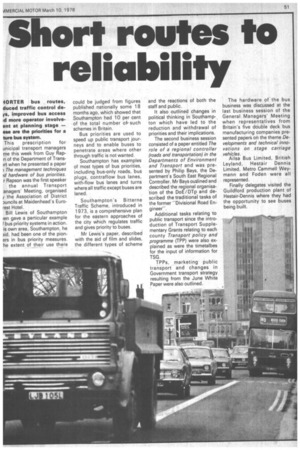Short routes to reliability
Page 53

If you've noticed an error in this article please click here to report it so we can fix it.
1ORTER bus routes, duced traffic control deo, improved bus access id more operator involveant at planning stage — ese are the priorities for a ture bus system.
This prescription for unicipal transport managers me this week from Guy Rapn of the Department of Trans)rt when he presented a paper The management techniques !cl hardware of bus priorities. r Rapson was the first speaker the annual Transport anagers' Meeting, organised the Association of District puncils at Maidenhead's Eurorest Hotel.
Bill Lewis of Southampton len gave a particular example I bus priority systems in action. is own area, Southampton, he aid, had been one of the pioners in bus priority measures. he extent of their use there could be judged from figures published nationally some 18 months ago, which showed that Southampton had 10 per cent of the -total number ofsuch schemes in Britain.
Bus priorities are used to speed up public transport journeys and to enable buses to penetrate areas where other through traffic is not wanted.
Southampton has examples of most types of bus priorities, including bus-only roads, bus plugs, contraflow bus lanes, with-flow bus lanes and turns where all traffic except buses are laned.
Southampton's Bitterne Traffic Scheme, introduced in 1973, is a comprehensive plan for the eastern approaches of the city which regulates traffic and gives priority to buses.
Mr Lewis's paper, described with the aid of film and slides, the different types of scheme and the reactions of both the staff and public.
It also outlined changes in political thinking in Southampton which have led to the reduction and withdrawal of priorities and their implications.
The second business session consisted of a paper entitled The role of a regional controller (roads and transportation) in the Departments of Environment and Transport and was presented by Philip Bays, the Department's South East Regional Controller. Mr Bays outlined and described the regional organisation of the DoE/DTp and described the traditional tasks of the former "Divisional Road Engineer".
Additional tasks relating to public transport since the introduction of Transport Supplementary Grants relating to each county Transport policy and programme (TPP) were also explained as were the timetalbes for the input of information for TSG.
TPPs, marketing public transport and changes in Government transport strategy resulting from the June White Paper were also outlined.
The hardware of the bus business was discussed at the last business session of the General Managers' Meeting when representatives from Britain's five double deck bus manufacturing companies presented papers on the theme Developments and technical innovations on stage carriage vehicles.
Ailsa Bus Limited, British Leyland, Hestair Dennis Limited, Metro Cammell Weymann and Foden were all represented.
Finally delegates visited the Guildford production plant of Hestair-Dennis where they had the opportunity to see buses being built.




















































































































